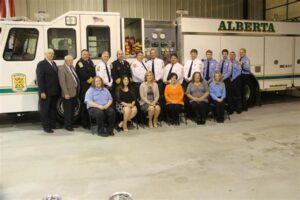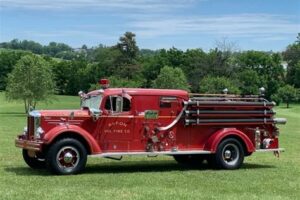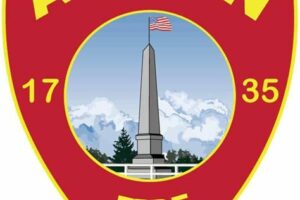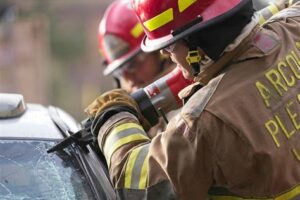Table of Contents
The Volunteer Fire Department Chain of Command is a hierarchical structure that ensures effective organization and communication within the department. It outlines the roles and responsibilities of individuals at different levels, from the Chief to the firefighters. Understanding this chain of command is crucial for maintaining a well-coordinated and efficient response to emergencies.
When disaster strikes, there is no time to waste. Lives are at stake and quick action is crucial. That’s where the Volunteer Fire Department Chain of Command comes into play. With a well-structured hierarchy, this organization ensures that every decision is made swiftly and efficiently, allowing firefighters to respond to emergencies with precision. From the fire chief to the newest recruit, each member of the team has a specific role and responsibility, forming an unbreakable chain that holds the community’s safety at its core.
The Importance of a Clear Chain of Command in Volunteer Fire Departments
Volunteer fire departments play a crucial role in communities, providing emergency response services and ensuring public safety. Despite their voluntary nature, these departments operate with a structured chain of command to effectively manage operations during emergencies. Maintaining a clear and organized hierarchy is essential for the smooth functioning of any fire department, including those staffed by volunteers. This article explores the significance of a well-defined chain of command in volunteer fire departments and highlights the roles and responsibilities of key positions within this structure.
The Fire Chief: Leading the Way
At the top of the chain of command in a volunteer fire department is the Fire Chief. This position carries immense responsibility and requires strong leadership skills. The Fire Chief oversees all operations, sets departmental goals, and ensures adherence to standards and regulations. They serve as the primary liaison between the department and other agencies, such as city councils or county governments. Additionally, the Fire Chief provides guidance and mentorship to other members of the department.
Assistant Chiefs: Supporting the Fire Chief
The Fire Chief is often supported by one or more Assistant Chiefs. These individuals assist in managing day-to-day operations, supervise personnel, and assume leadership duties in the absence of the Fire Chief. Assistant Chiefs may specialize in specific areas, such as training, equipment maintenance, or community outreach. They work closely with the Fire Chief to implement policies and ensure the effective functioning of the department.
Captains: Leading Teams on the Ground
Captains hold a critical position within the volunteer fire department, responsible for leading teams during emergency incidents. They coordinate firefighting efforts, assign tasks to team members, and ensure everyone’s safety. Captains also oversee training sessions and drills, ensuring that personnel are prepared to handle various scenarios. Their experience and knowledge make them valuable resources for both senior officers and newer recruits.
Lieutenants: Assisting Captains
Lieutenants work hand in hand with Captains, providing support and assistance during emergency operations. They supervise smaller groups within a team and act as a bridge between firefighters and higher-ranking officers. Lieutenants also help with training new recruits, evaluating their progress, and offering guidance. Their role is vital in maintaining effective communication and coordination on the ground.
Firefighters: The Backbone of the Department
The backbone of any volunteer fire department is its firefighters. These dedicated individuals undergo extensive training to respond to emergencies efficiently. Firefighters perform various tasks, including firefighting, rescue operations, and medical assistance. They work under the leadership of officers and rely on their guidance during emergency situations. While firefighters may not have formal authority, their commitment and teamwork are fundamental to the department’s success.
Administrative Personnel: Supporting Operations
Besides operational positions, volunteer fire departments also require administrative personnel to handle non-emergency tasks. These roles include administrative assistants, bookkeepers, and public relations officers. Administrative personnel ensure that the department runs smoothly by managing paperwork, finances, and public outreach. Their contribution allows operational personnel to focus on emergency response activities.
Board of Directors: Providing Oversight
Most volunteer fire departments have a Board of Directors who provide oversight and governance. Comprised of community members, these individuals volunteer their time to guide the department’s strategic direction, manage finances, and represent the interests of the community. The Board of Directors collaborates with the Fire Chief and other officers to make important decisions and allocate resources.
Community Volunteers: Supporting the Department
In addition to the operational and administrative personnel within the department, community volunteers play a vital role in supporting the overall mission. These individuals contribute by fundraising, organizing community events, and providing moral support to the department. The involvement of community volunteers strengthens the bond between the department and the community it serves.
Maintaining Communication: The Key to Success
Effective communication is the cornerstone of any volunteer fire department’s chain of command. Regular meetings, trainings, and drills ensure that information flows smoothly throughout the department. Communication channels must be open and transparent, allowing for feedback and the exchange of ideas. This cohesive approach fosters trust and cooperation among all members, enhancing the department’s capabilities during emergencies.
Adapting to Change: A Dynamic Chain of Command
A volunteer fire department’s chain of command is not static; it must adapt to changing circumstances. As departments grow or face new challenges, positions may be added or modified to meet evolving needs. Flexibility and a willingness to embrace change are essential for a department to remain effective and responsive to its community’s needs.
In conclusion, a clear chain of command is crucial for the smooth operation of volunteer fire departments. It provides structure, accountability, and coordination during emergency situations while allowing for efficient day-to-day management. Each position within the chain of command, from the Fire Chief to community volunteers, plays a vital role in ensuring public safety. By working together and maintaining effective communication, volunteer fire departments continue to serve as pillars of their communities.
Introduction to the Chain of Command
The Volunteer Fire Department operates under a structured chain of command, ensuring effective coordination and clear lines of authority. This hierarchical structure is crucial in emergency situations when quick decision-making is paramount. It enables the department to efficiently allocate resources, manage personnel, and maintain effective communication both internally and externally.
Fire Chief
At the top of the chain of command is the Fire Chief, who oversees the entire Volunteer Fire Department. The Fire Chief is responsible for setting departmental goals, policies, and objectives. Additionally, they provide strategic direction, ensure compliance with regulations, and make critical decisions during emergencies. This position requires exceptional leadership skills, extensive fire service experience, and the ability to foster a cooperative and supportive work environment.
Deputy Fire Chief
Assisting the Fire Chief is the Deputy Fire Chief, who acts as the second-in-command. In the absence of the Fire Chief, the Deputy Fire Chief assumes their responsibilities and authority. They assist in managing day-to-day operations, coordinating emergency responses, conducting training sessions, and implementing departmental policies. The Deputy Fire Chief plays a crucial role in the overall efficiency and effectiveness of the department.
Division Chiefs
The Volunteer Fire Department is further divided into various divisions, each headed by a Division Chief. These divisions typically include Operations, Training, Fire Prevention, and Administration. Division Chiefs are responsible for overseeing their respective areas, implementing departmental policies within their divisions, and ensuring that all tasks are carried out efficiently. They report directly to the Fire Chief or the Deputy Fire Chief, providing updates on divisional activities and addressing any concerns.
Captains
Captains are in charge of the company-level operations within the Volunteer Fire Department. They supervise their assigned company during emergencies, conduct drills and practice sessions, and ensure compliance with safety protocols. Captains also play a key role in mentoring and training junior firefighters, empowering them with the necessary skills and knowledge. They act as a crucial link between the leadership and firefighters on the ground, relaying information and coordinating responses.
Lieutenants
Lieutenants support the Captains and assist in managing the day-to-day operations within their respective companies. They play a vital role in maintaining discipline, overseeing crew assignments, and ensuring that equipment is ready for response at all times. Lieutenants often serve as incident commanders during smaller incidents, taking charge until higher-ranking officials arrive. They also facilitate communication between firefighters and the chain of command, conveying important instructions and updates.
Firefighters
Firefighters are the backbone of the Volunteer Fire Department and form the largest group within the organization. They undergo extensive training to develop skills in fire suppression, rescue operations, emergency medical services, and other essential firefighting techniques. While they report to their immediate supervisors, such as Lieutenants and Captains, firefighters are expected to uphold the department’s values, follow procedures, and actively contribute during emergency operations to ensure community safety.
Auxiliary and Support Staff
Alongside the operational personnel, the Volunteer Fire Department relies on auxiliary and support staff who fulfill crucial roles. These may include administrative assistants, logistics coordinators, communications personnel, and maintenance technicians, among others. These individuals provide critical support to the operational units and play an essential part in ensuring the smooth functioning of the Volunteer Fire Department’s day-to-day activities.
In the world of emergency response, the Volunteer Fire Department Chain of Command plays a crucial role in ensuring effective coordination and efficient operations. This hierarchical structure allows for clear communication, swift decision-making, and the successful execution of firefighting missions. Let us delve into the different levels of the chain of command and understand its significance.
1. Chief Officer:
- The Chief Officer serves as the overall leader of the Volunteer Fire Department, responsible for strategic planning, policy formulation, and resource management.
- With extensive experience and expertise, the Chief Officer sets the department’s vision, establishes goals, and guides the team towards excellence.
- They maintain a strong liaison with other agencies and ensure compliance with regulations and standards.
2. Deputy Chief:
- Assisting the Chief Officer, the Deputy Chief holds a critical position in the chain of command.
- They supervise and coordinate the activities of various divisions within the department, such as operations, training, and administration.
- Deputy Chiefs also play a key role in incident command, assuming control during emergencies and ensuring effective implementation of strategies.
3. Battalion Chiefs:
- Battalion Chiefs are responsible for specific geographical areas or specialized functions within the department.
- They oversee multiple fire stations, manage personnel, and assess the needs of their assigned areas.
- These individuals play a vital role in executing firefighting operations, ensuring the safety of both firefighters and the public.
4. Captains:
- As frontline supervisors, Captains lead individual fire companies and play a crucial role in day-to-day operations.
- They are responsible for ensuring the readiness of their crews, conducting drills and training sessions, and maintaining equipment and apparatus.
- Captains act as the link between their firefighters and higher-ranking officers, relaying information and providing guidance during emergencies.
5. Firefighters:
- At the foundation of the Volunteer Fire Department Chain of Command are the firefighters, the brave men and women who respond to emergencies.
- These dedicated individuals undergo rigorous training to develop essential firefighting skills and maintain physical fitness.
- Firefighters follow the orders of their officers, work as a team, and risk their lives to protect the community.
The Volunteer Fire Department Chain of Command ensures a structured approach to emergency response, promoting accountability and enhancing operational effectiveness. Each level within this hierarchy serves a distinct purpose, contributing to the success of firefighting missions. By adhering to this well-defined structure, volunteer fire departments can effectively combat fires, save lives, and safeguard their communities.
Thank you for taking the time to explore our blog and learn more about the Volunteer Fire Department Chain of Command. Understanding the hierarchy and structure within a fire department is crucial for its effective operation and the safety of its members and the community it serves. In this article, we have discussed the importance of having a clear chain of command and the roles and responsibilities of each position within the department.
Firstly, let’s discuss the significance of a chain of command in a Volunteer Fire Department. Having a well-defined chain of command ensures that there is order and accountability within the department. It provides a clear line of authority from the top leadership down to the firefighters on the front lines. This ensures that decisions are made efficiently and tasks are delegated appropriately. Without a chain of command, chaos can ensue, leading to confusion, miscommunication, and ultimately, a lack of effectiveness in emergency response situations.
Now, let’s delve into the different positions within the chain of command. At the top of the hierarchy is the Fire Chief, who is responsible for the overall management and administration of the department. The Fire Chief sets the department’s goals, develops policies and procedures, and oversees the training and development of personnel. Reporting directly to the Fire Chief are the Deputy Chiefs and Battalion Chiefs, who assist in managing various aspects of the department’s operations. They may be assigned specific duties such as overseeing specific divisions or responding to major incidents. Below them are the Captains, Lieutenants, and Engineers, who lead firefighting crews and are responsible for the day-to-day operations at the station level. Finally, we have the firefighters, who are the backbone of the department and carry out the tasks necessary to respond to emergencies effectively.
In conclusion, understanding the Volunteer Fire Department Chain of Command is vital for both firefighters and the public they serve. It ensures a well-organized and efficient response to emergencies, as well as the safety and well-being of all involved. By having a clear hierarchy, tasks can be delegated appropriately, decisions can be made swiftly, and communication can flow seamlessly. We hope that this article has shed some light on the importance of the chain of command within a Volunteer Fire Department and its role in safeguarding our communities. Thank you for reading!
.
People also ask about the Volunteer Fire Department Chain of Command:
What is the chain of command in a volunteer fire department?
In a volunteer fire department, the chain of command typically follows a hierarchical structure. At the top, you have the Chief or Fire Commissioner, who is responsible for overseeing the entire department. Below the Chief, there may be Assistant Chiefs or Captains who assist in managing operations. The chain of command then extends to Lieutenants, Sergeants, and other officers, followed by the general members of the department.
What are the responsibilities of a Fire Chief in a volunteer fire department?
The Fire Chief in a volunteer fire department holds the highest-ranking position and carries significant responsibilities. They are in charge of overall departmental administration, strategic planning, budgeting, and resource allocation. The Fire Chief ensures that all firefighting and emergency response activities are carried out efficiently and effectively. They also coordinate with other agencies, conduct training, and establish departmental policies.
Who reports directly to the Fire Chief in a volunteer fire department?
In a volunteer fire department, Assistant Chiefs or Captains often report directly to the Fire Chief. These individuals assist the Chief in managing day-to-day operations, overseeing specific divisions or stations, and ensuring compliance with departmental protocols. Additionally, officers such as Lieutenants and Sergeants may report to the Fire Chief or the Assistant Chiefs, depending on the department’s structure.
What is the role of officers in a volunteer fire department?
Officers play a crucial role in a volunteer fire department’s chain of command. They are responsible for leading and supervising firefighters during emergency incidents. Officers ensure that all personnel follow proper procedures, maintain discipline, and prioritize safety. They may also participate in training, conduct performance evaluations, and assist in making operational decisions.
How are volunteer firefighters selected for officer positions?
The process of selecting volunteer firefighters for officer positions varies among departments. Generally, individuals who demonstrate exceptional leadership skills, experience, and dedication to the department are considered for officer roles. The selection process may involve interviews, assessments, and recommendations from senior members. It is crucial that officers possess strong communication abilities, decision-making aptitude, and the ability to motivate and guide their fellow firefighters.
Remember, the structure and specific roles within a volunteer fire department’s chain of command can vary. It is best to consult your local department’s guidelines and policies for accurate and detailed information.






